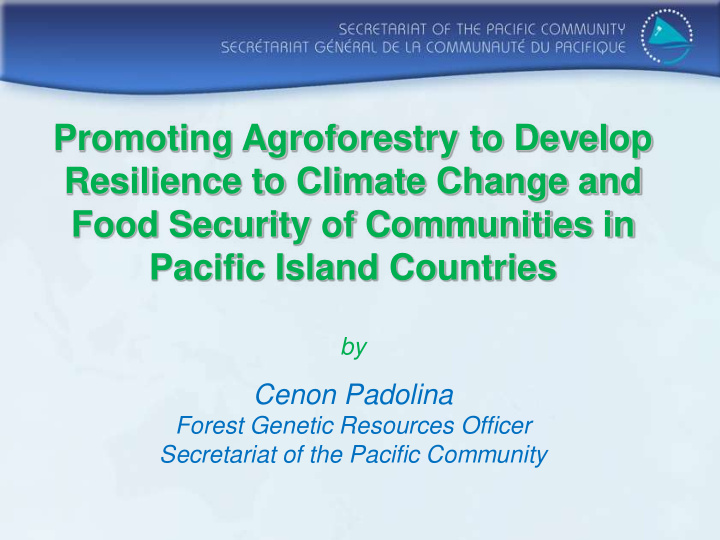



Promoting Agroforestry to Develop Resilience to Climate Change and Food Security of Communities in Pacific Island Countries by Cenon Padolina Forest Genetic Resources Officer Secretariat of the Pacific Community
The Pacific Community
The Pacific Community • PACIFIC COVERS ALMOST 33% OF THE EARTH’S SURFACE (about 2% only is land) • MELANESIAN COUNTRIES:, Fiji Is., New Caledonia, Papua New Guinea, Solomon Is. and Vanuatu • POLYNESIAN COUNTRIES: Am. Samoa, Cooks Is., French Polynesia, Hawaii, Niue, Samoa, Tokelau, Tonga, Tuvalu and Wallis & Futuna • MICRONESIAN COUNTRIES: FSM, Guam, Kiribati, Marshall Is., Nauru, Northern Marianas Is. And Palau • MOSTLY SMALL LAND AREAS WITH LIMITED FORESTS • ONLY 4-6 COUNTRIES OUT OF 22 HAVE A FOREST INDUSTRY; IMPORTANT TO ECONOMIC DEVELOPMENT
SECRETARIAT OF THE PACIFIC COMMUNITY (SPC) SPC was established as an international organisation in 1947 under the Canberra Agreement and works to serve the development goals of its member countries and territories by delivering technical, scientific, research policy and training services, Membership – 22 PICTs + AUSTRALIA, FRANCE, NZ & USA It has 7 technical divisions that works on 20 sectors: - Natural resources sectors (agriculture, aquaculture fisheries, forestry, water and sanitation) - Human and social development sectors (education, health, culture, gender, youth, human rights)
SPC’s vision and mission • Our vision for the region is a secure and prosperous Pacific Community whose people are educated and healthy and manage their resources in an economically, environmentally and socially sustainable way. • Our mission is to help Pacific Island people position themselves to respond effectively to the challenges they face and make informed decisions about their future and the future they wish to leave for the generations that follow.
Major Issues in the Pacific Community Climate Change – The Pacific Island Countries, particularly the atolls, are the most vulnerable to climate change ( sea level rise, storm surge, drought, floods, etc.) Food and Nutritional Security - The global food crisis highlighted how vulnerable the Pacific is as a result of its reliance on imported food. The escalating fuel prices experienced globally reinforced the Pacific’s vulnerability. Non-Communicable Diseases (NCDs) - The Pacific Island countries have the highest prevalence of obesity and diabetes in the world. It is one of the leading causes of preventable deaths in the Pacific Rim. According to Forbes, Pacific island nations (Nauru, FSM, Cook Is., Tonga, Niue, Samoa, Palau and Kiribati) make up the top seven on a 2007 list of fattest countries, and eight of the top ten
FORESTS AND TREES OFFER ONE OF THE BEST SOLUTIONS FOR PICTs TO COPE WITH CLIMATE CHANGE AND OTHER CHANGING CIRCUMSTANCES
FORESTS AND TREES FOCAL POINT FOR FORESTRY IN THE PACIFIC MAIN AREAS OF FOCUS: • SUSTAINABLE FOREST MANAGEMENT – including sustainable natural forest harvesting, watershed management & mangrove management • SUSTAINABLE UTILISATION OF FOREST PRODUCTS – including both wood and non-wood forest products • AGROFORESTRY • FOREST GENETIC RESOURCES
Criteria on Selecting Tree Species for Agroforestry in the Pacific – Trees that provide timber, posts, fuels and handicrafts – Trees that provide food, fruits and nuts – Trees that provide soil nutrition and protection – Trees that provide forage and fodder – Trees that provide medicine and cultural goods, – Trees that contribute to environmental protection, biological conservation and carbon sequestration
Potential Tree species for Agroforestry Timber tree species: – Teak ( Tectona grandis ) Tree species for essential oil: – Poumoli ( Flueggea flexuosa ) - Sandalwood ( Santalum spp. ) - Coconut ( Cocus nucifera ) – Caribbean Pine (Pinus caribaea - Dilo ( Calophyllum inophyllum ) – Mahogany ( Swietenia macrophylla ) - Mokosoi ( Cananga odorata ) – Terminalia cattappa - Agar wood ( Aquilaria spp .) – Pandanus spp. Trees that provide food, fruits & nuts Multipurpose Trees: - Gliricidia sepieum - Coconut ( Cocus nucifera ) - Azadirachta indica - Breadfruit ( Artocarpus altiles ) - Moringa Oleifera - Coffee ( Coffea arabica ) - Morinda citrifolia - Cocoa ( Theobroma cacao ) - Ngale nut ( Canarium indicum ) - Mango ( Mangifera indica ) - Avocado ( Persia americana ) - Papaya ( Carica papaya ) - Citrus spp.
Capacity Building
Education and Awareness
Establishment of Agroforestry Demonstration Areas
Supply and exchange of improved planting material SPC Facilities: - Center for Pacific Crops and Trees (CEPACT) - Pacific Islands Tree Seed Centre (PITSC)
AgAgroforestry Practices in Fijices in Fiji
Agroforestry Practices in Solomon Is. Teak and Flueggea agro forestry trial plots (Forestry Dept.) Sweet Potato planted under rows of Eucalyptus-KFPL
Issues and Challenges
Agroforestry Practices in the Atolls (Kiribati) Cocus nucifera for food Pandanus tectoris for food, medicine, firewood, timbers medicine, timbers, housing materials like thatches
Issues and Challenges Land tenure Extension (Awareness and education) Product development and market access Intellectual property rights Access and benefits sharing Supply and exchange of improved planting materials Policies, laws and regulations
Vinaka vakalevu (Thank you) !
Recommend
More recommend